#david koff
Explore tagged Tumblr posts
Text









BLACKS BRITANNICA (1978) dir. DAVID KOFF
60 notes
·
View notes
Text

Blacks Britannica (1978) dir. David Koff
17 notes
·
View notes
Text




just thought starksy looked particularly cute here
#red is HIS color#also hutch wore that shirt before#they share clothes !!!#they also don't JUST share clothe *koff koff*#starsky and hutch#starsky & hutch#david starsky#ken hutchinson#paul michael glaser
27 notes
·
View notes
Text


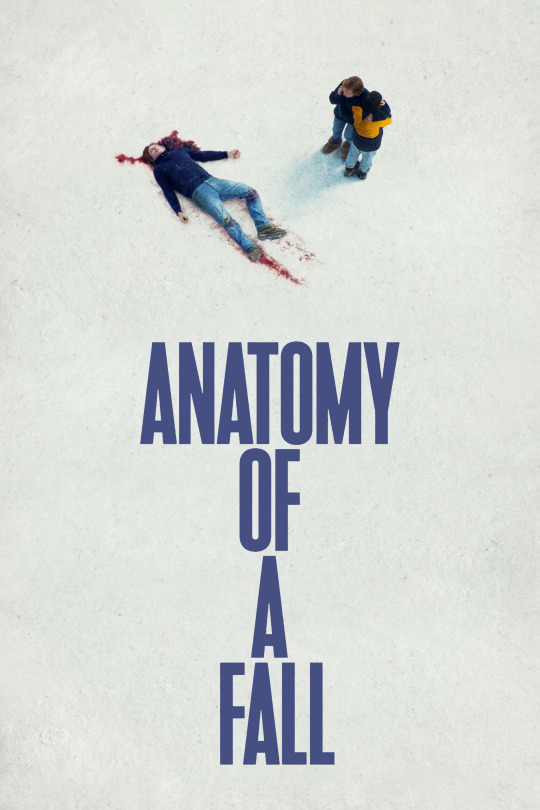


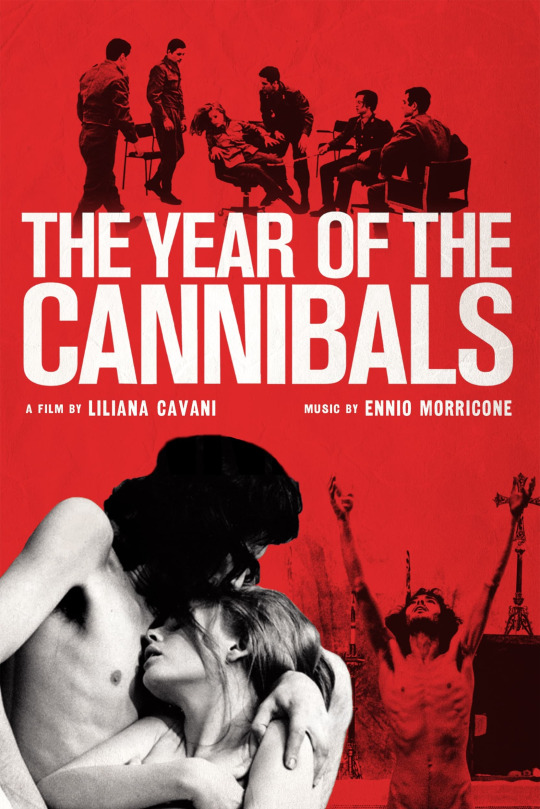



as is tradition here are my top nine new-to-me watches of the year—in no particular order (l-r, top row to bottom row):
the african desperate (martine syms, 2022) not a pretty picture (martha coolidge, 1975) anatomy of a fall (justine triet, 2023) the girls (mai zetterling, 1968) network (sidney lumet, 1976) the year of the cannibals (liliana cavani, 1970) all the beauty and the bloodshed (laura poitras, 2022) straight on till morning (peter collinson, 1972) microhabitat (jeon go-woon, 2017)
i hit 150 total films and my continual goal of half of the films by women and nonbinary filmmakers, and still definitely need to keep up with deliberately seeking out films by directors of color! feel free to tell me your faves if you’ve seen any of these 🖤👀🎬🍿🎥
i'll tag @privatejoker / @wanlittlehusk / @majorbaby / @edwardalbee / @draftdodgerag / @lesbiancolumbo / @frmulcahy / @nelson-riddle-me-this / @firewalkwithmedvd and anyone else who'd like to share their top watches of the year!
full list of films for the year is included below, favorites are bolded in red:
Farewell Amor (Ekwa Msangi, 2020)
Hell Camp: Teen Nightmare (Liza Williams, 2023)
Blacks Britannica (David Koff, 1978)
New Year, New You (Sophia Takal, 2023)
Family Band: The Cowsills Story (Louise Palanker and Bill Filipiak, 2011)
The Color Purple (Blitz Bazawule, 2023)
The Apology (Alison Star Locke, 2022)
Close (Lukas Dhont, 2022)
Unintended (Anja Murmann, 2018)
Other People’s Children (Liz Hinlein, 2015)
Omega Rising Women of Rastafari (D. Elmina Davis, 1988)
The Gypsy Moths (John Frankenheimer, 1969)
Be My Cat: A Film for Anne (Adrian Țofei, 2015)
Insomnia (Christopher Nolan, 2002)
Chowchilla (Paul Solet, 2023)
Intimate Relations (Philip Goodhew, 1996)
Monument (Jagoda Szelc, 2018)
After Sherman (Jon Sesrie Goff, 2022)
Remnants of the Watts Festival (Ulysses Jenkins, 1980)
Network (Sidney Lumet, 1976)
The Taking of Pelham One Two Three (Joseph Sargent, 1974)
Down Low (Rightor Doyle, 2023)
Our Father, the Devil (Ellie Foumbi, 2021)
The Zone of Interest (Jonathan Glazer, 2023)
Youngblood (Noel Nosseck, 1978)
Joy Division - Under Review (Christian Davies, 2006)
Being Frank: The Chris Sievey Story (Steve Sullivan, 2018)
Sun Ra: A Joyful Noise (Robert Mugge, 1980)
Fanny: The Right To Rock (Bobbi Jo Hart, 2021)
Depeche Mode: The Dark Progression (Alec Lindsell, 2009)
Kraftwerk And The Electronic Revolution (Thomas Arnold, 2008)
Blank City (Celine Danhier, 2010)
Oliver Sacks: His Own Life (Ric Burns, 2019)
Monster (Hirokazu Kore-eda, 2023)
Black Is Beltza (Fermín Muguruza, 2018)
Werewolf (Ashley McKenzie, 2016)
The Humans (Stephen Karam, 2021)
Relative (Tracey Arcabasso Smith, 2022)
The Believer (Henry Bean, 2001)
Lost Angel: The Genius of Judee Sill (Brian Lindstrom and Andy Brown, 2022)
Animals (Collin Schiffli, 2014)
Scott Walker: 30 Century Man (Stephen Kijak, 2006)
Novitiate (Maggie Betts, 2017)
Hunger (Henning Carlsen, 1966)
Late Night With The Devil (Cameron Cairnes and Colin Cairnes, 2023)
The Stunt Man (Richard Rush, 1980)
New York Doll (Greg Whiteley, 2005)
The Iron Claw (Sean Durkin, 2023)
Your Fat Friend (Jeanie Finlay, 2023)
Scarred Justice: The Orangeburg Massacre 1968 (Bestor Cram and Judy Richardson, 2008)
Targets (Peter Bogdanovich, 1968)
Uptight (Jules Dassin, 1968)
Messiah of Evil (Gloria Katz and Willard Huyck, 1973)
Plastic Paradise (Brett O’Bourke, 2013)
You Hurt My Feelings (Nicole Holofcener, 2023)
Pretty Poison (Noel Black, 1968)
The Shout (Jerzy Skolimowski, 1978)
Shakedown (Leilah Weinraub, 2018)
Class of 1984 (Mark L. Lester, 1982)
Betty: They Say I’m Different (Philip Cox, 2017)
Beautiful Boy (Felix van Groeningen, 2018)
Anatomy of a Fall (Justine Triet, 2023)
Gimme Shelter (Albert Maysles, David Maysles, and Charlotte Zwerin, 1970)
The Beach Boys (Frank Marshall and Thom Zimny, 2024)
High and Low (Kevin Macdonald, 2023)
Brats (Andrew McCarthy, 2024)
I Saw The TV Glow (Jane Schoenbrun, 2023)
The Talented Mr. Ripley (Anthony Minghella, 1999)
Altered States (Ken Russell, 1980)
This Closeness (Kit Zauhar, 2023)
How To Have Sex (Molly Manning Walker, 2023)
American Commune (Rena Mundo Croshere and Nadine Mundo, 2013)
Look In Any Window (William Alland, 1961)
Private Property (Leslie Stevens, 1960)
We’re Still Here: Johnny Cash’s Bitter Tears Revisited (Antonino D’Ambrosio, 2015)
The Wobblies (Stewart Bird and Deborah Shaffer, 1979)
Last Summer Won’t Happen (Tom Hurwitz and Peter Gessner, 1968)
Goodbye Gemini (Alan Gibson, 1970)
Keyboard Fantasies: The Beverly Glenn-Copeland Story (Posy Dixon, 2019)
The Most Beautiful Boy in the World (Kristina Lindström and Kristian Petri, 2021)
The Passenger (Carter Smith, 2023)
The Boys Who Said No (Judith Ehrlich, 2020)
Synecdoche, New York (Charlie Kaufman, 2008)
Karen Carpenter: Starving for Perfection (Randy Martin, 2023)
...And Justice For All (Norm Jewison, 1978)
I Used To Be Funny (Ally Pankiw, 2023)
Badlands (Terrence Malick, 1973)
Straight On Till Morning (Peter Collinson, 1972)
The Same Difference: Gender Roles in the Black Lesbian Community (Nneka Onuorah, 2015)
Thanksgiving (Eli Roth, 2023)
Sorry/Not Sorry (Caroline Suh and Cara Mones, 2023)
Am I OK? (Tig Notaro and Stephanie Allynne, 2022)
Joan Baez: I Am a Noise (Maeve O’Boyle, Miri Navasky, and Karen O’Connor, 2023)
No Direction Home (Martin Scorsese, 2005)
Shutter Island (Martin Scorsese, 2010)
Water Lilies (Céline Sciamma, 2007)
The Strings (Ryan Glover, 2020)
The Crucible (Nicholas Hytner, 1996)
Woman of the Hour (Anna Kendrick, 2024)
The Platform (Galder Gaztelu-Urrutia, 2019)
Tabloid (Errol Mark Morris, 2010)
Will & Harper (Josh Greenbaum, 2024)
Miller’s Girl (Jade Halley Bartlett, 2024)
Give Me Pity! (Amanda Kramer, 2022)
Landlocked (Paul Owens, 2021)
Perfect Love (Catherine Breillat, 1996)
Not a Pretty Picture (Martha Coolidge, 1975)
Seeking Mavis Beacon (Jazmin Jones, 2024)
Renfield (Chris McKay, 2023)
Compulsion (Richard Fleischer, 1959)
An Angel At My Table (Jane Campion, 1990)
Longlegs (Oz Perkins, 2024)
Rare Beasts (Billie Piper, 2019)
Nightman (Mélanie Delloye-Betancourt, 2023)
The Changin’ Times of Ike White (Daniel Vernon, 2020)
The Substance (Coralie Fargeat, 2024)
The Year of the Cannibals (Liliana Cavani, 1970)
Fanatical: The Catfishing of Tegan and Sara (Erin Lee Carr, 2024)
The Loneliest Planet (Julia Loktev, 2011)
Marjoe (Howard Smith and Sarah Kernochan, 1972)
Witches (Elizabeth Sankey, 2024)
Angela (Rebecca Miller, 1995)
The Morning After (Richard T. Heffron, 1974)
Beach Rats (Eliza Hittman, 2017)
Last Summer (Catherine Breillat, 2023)
The Fits (Anna Rose Holmer, 2015)
Hold Your Breath (Karrie Crouse and Will Joines, 2024)
What Comes Around (Amy Redford, 2022)
Dear Zachary: A Letter to a Son About His Father (Kurt Kuenne, 2008)
Priscilla (Sofia Coppola, 2023)
The Girls (Mai Zetterling, 1968)
Sweetie (Jane Campion, 1989)
Victim/Suspect (Nancy Schwartzman, 2023)
The African Desperate (Martine Syms, 2022)
Les Nôtres (Jeanne Leblanc, 2020)
A Sacrifice (Jordan Scott, 2024)
All the Beauty and the Bloodshed (Laura Poitras, 2022)
My Name is Not Ali (Viola Shafik, 2011)
Committed (Sheila McLaughlin and Lynne Tillman, 1984)
Chained (Jennifer Lynch, 2012)
The Hour of Liberation Has Arrived (Heiny Srour, 1974)
All Power To The People! (Lee Lew-Lee, 1997)
Night Moves (Kelly Reichardt, 2013)
Destroyer (Karyn Kusama, 2018)
Late Night (Nisha Ganatra, 2023)
The Year Between (Alex Heller, 2022)
Loved (Erin Dignam, 1997)
Girl In The Picture (Skye Borgman, 2022)
Microhabitat (Jeon Go-Woon, 2017)
Dear Ex (Mag Hsu and Chih-yen Hsu, 2018)
#i might watch more films between now and tomorrow so who knows but here's the final list; 150 new to me features feels like a good yearly#goal and if i surpass it all the better lol#the african desperate was my top film of the year <3
43 notes
·
View notes
Text
there will be a puzzle where one of your targets is a web infrastructure engineer who puts backdoors in iphones or something and he's wearing a randomly generated fursuit and you must deduce which one he is using a series of clues And I think there should be like an interaction where furrty-seven can wear different suits to get to different areas where he makes a different animal joke each time like
[in a hyena suit, rizzing up Jasonafex] "You and I are both...opportunistic predators." [Wearing the LED color-changing suit of a popufur dj] "you look different bra" "I just shed my skin." [Killing target using a skunk suit with lethal chemical in the tail] "K-koff...something sm-smells like..." "Gas, Mister Wusky."
this will make David Bateson quit playing this part
They’ll never do a Hitman level set in a Furry Convention because gamers would absolutely ruin it but imagine. like the target isn’t a furry he just owns a hotel that happens to have one every year but you can disguise yourself in a fursuit and some guy will ask you “what species is your sona” and 47 would be like “a wolf. i always felt a connection with…hunters.” and then diana would be like “let’s see if you can sniff out some information, furrty-seven” and then he comes to my house and kills me for writing this
69K notes
·
View notes
Text

Saturday Afternoon Reggae Show
DJ LeBaron Lord King October 5, 2024
#SaturdayAfternoonReggaeShow
4:00 PM
Anthony Charlton- I Rather Be in Zion
4:03 PM
Rising Son Forgive- Them Jah
4:06 PM
Buju Banton Driver
4:09 PM
The Wailers Redemption Song
4:13 PM
Eesah Hold a Vibe
4:16 PM
Iyatundeh Hunger Days
4:19 PM
Sevana Blessed
4:22 PM
Tarrus Riley Children A Pree Wi
4:25 PM
Protoje Ja
4:29 PM
Khalilah Rose Alkebulan
4:33 PM
Koffe Burning
4:36 PM
Skip Marley Make Me Feel
4:39 PM
Rudolph Francis A So the System Work
4:43 PM
Lacksley Castell Genie in a Jar
4:49 PM
Ziggy Marley Circle of Peace
4:53 PM
Protoje Bout Noon
4:57 PM
Erykah Badu In Love with You
5:02 PM
Stephen Marley Hey Baby
5:07 PM
Lutan Fyah Bla Bla Bla
5:10 PM
Kabaka Pyramid Mr. Rastaman
5:13 PM
Yaksta No More Sales
5:17 PM
Lila Iké Dinero
5:20 PM
Norrac Hypocrites
5:24 PM
Young Garvey War
5:30 PM
Jo Mersa Marley Rock and Swing
5:33 PM
Upsetta Weekend
5:35 PM
DeZaire When Devils Came
5:42 PM
Dre Island You Take Me High
5:46 PM
Yellowman Lost Mi Love
5:51 PM
Black Uhuru Guess Who's Coming to Dinner
5:58 PM
The Wailers The Heathen
6:00 PM
Wizkid Blessed
6:05 PM
Skip Marley Enemy
6:07 PM
Eek-A-Mouse Wa-Do-Dem
6:15 PM
Earl Cunningham Listen to the Words of the Father
6:16 PM
Musical Youth Pass the Dutchie
6:19 PM
Steel Pulse Your House
6:22 PM
Sister Nancy One Two
6:27 PM
Burning Spear Walking in Dub
6:30 PM
Matisyahu One Day
6:33 PM
Nas & Damian Marley Patience
6:39 PM
Dan Gio Champion Sound
6:42 PM
Zion head Chalice Baptized
6:46 PM
Blanca Worthy
6:50 PM
Jahnice Island Time
6:55 PM
David Conscious Mighty Men
#kpooradio#reggae#reggaemusic#sanfrancisco#oakland#bayarea#california#jamaica#america#reggaeville2024#mylifeisreggae#kpoo#kpop#californiaroots#worldareggae#rastafari @reggaegistxtra_ng#Reggaeville#MaadSickReggaeville
0 notes
Text
The groundbreaking plan to map the entire human immune system
Freethink By David CoxMay 14, 2023 After spending more than 30 years of his life fighting the AIDS crisis, Wayne Koff found himself coming to a startling realization: namely, that we understand far more about how the HIV virus evolves and adapts over time than we do about how our own immune system responds to it. “I spent a long time on HIV vaccine development,” says Koff, adjunct professor of…
View On WordPress
0 notes
Text

Blacks Britannica, dir. David Koff [1978]
17 notes
·
View notes
Photo

David Lynch - Twin Peaks
Art by Rafael Koff
61 notes
·
View notes
Note
Could you maybe make a post with some of the most inspiring Daredevil pages? Stuff like him overcoming the Purple Man making him more depressed and hopeless in Waid's run, or the "I am Daredevil, and I am not Afraid." page from Soule's run. Those kind of pages always help me when I'm feeling down, it would be cool to see more in that vein.
I love this request, and yes, I can definitely do that! I draw a lot of inspiration from Daredevil too (and superhero comics in general; that’s one of the purposes of the genre, in my experience), and refusing to give up when everything is falling apart is one of Matt’s trademark moves. Here are a few of my favorite moments– and I’m including the ones you mentioned, since I love them and want to make sure other people have seen them too.
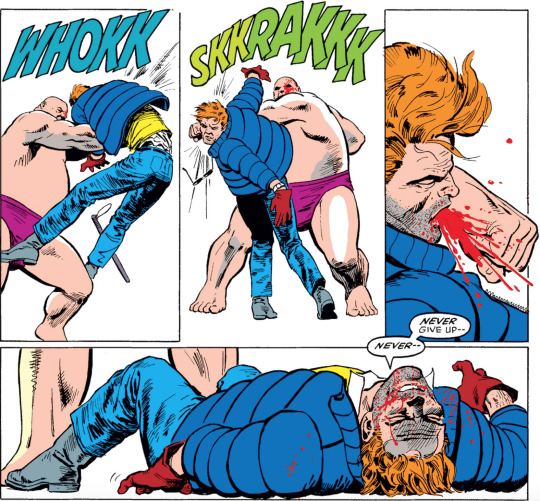
[ID: The Kingpin is brutally beating up Matt, who is in civvies. Matt falls on his back, his face bloody.]
Matt: “Never give up– never–”
Let’s start with a classic:

[ID: Daredevil is fighting Namor. He tries electrocuting him, but the blast knocks him to the ground. As Namor walks away, Daredevil reaches out and grabs his ankle before passing out.]
Namor: “This is madness!! Does your own life mean nothing to you!?? Have you no sense of fear??”
Matt: “Sure! But I seem to have carelessly misplaced it somewhere! Now, just stand there for a second, fella– I want to try something!”
Caption: “Taking one last desperate gamble, Daredevil joins the two live wires, hoping to stagger his super-human foe! […] But, once again, the power of the Sub-Mariner is greater than any could suppose, and it is he who recovers first– while the Man Without Fear, despite his insulated gloves– lies weak, and dazed, and helpless…! Yet, how can one measure the limitless courage of a fellow human? Although on the brink of unconsciousness– although racked with pain and fatigue– still the sightless crusader reaches out–!”
Matt: “Come back! You– you mustn’t fight the others–! They’re innocent– mustn’t be harmed– mustn’t–!”
Namor: “[…] I have fought the Fantastic Four, the Avengers, and other super-powered humans, but none has been more courageous than he, the most vulnerable of all! And out of respect to the courage of Daredevil, I shall not injure any humans! I shall fly above the waiting armed forces– and return to the sea where I am supreme!”
Daredevil vol. 1 #7 by Stan Lee and Wally Wood
The issue that introduced the red Daredevil costume also crafted one of the first memorable depictions of Matt’s boundless resilience. Namor the Sub-Mariner comes ashore to sue the human race, and hires Nelson and Murdock to represent him. When the situation goes awry, Namor becomes violent, and Matt tries to subdue him. While he gets thoroughly thrashed in this fight, Matt’s persistence impresses Namor enough to make him leave the human race alone (for now). That image of a nearly-unconscious Daredevil clinging to Namor’s ankle is fairly iconic, with– I feel– good reason.
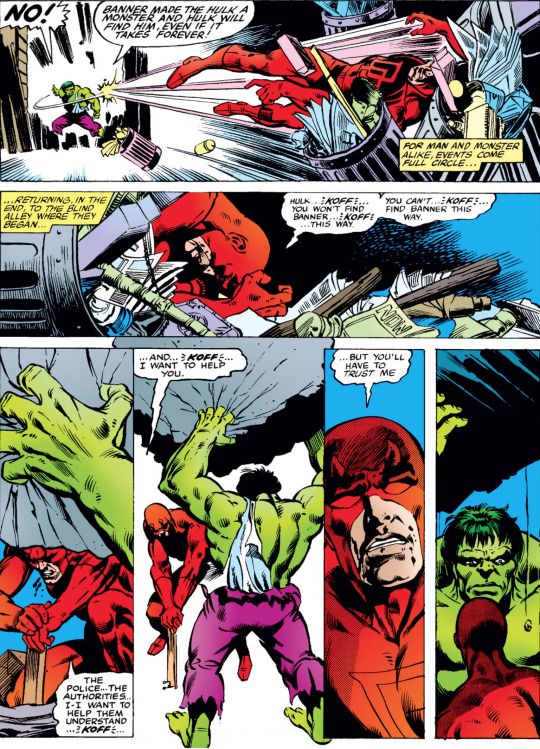
[ID: The Hulk backhands Daredevil a good distance, where he crashes into some trash cans. He is injured and bleeding, but he struggles back to his feet as the Hulk stands over him, deciding whether or not to finish him off.]
Hulk: “NO! Banner made the Hulk a monster and Hulk will find him, even if it takes forever!”
Matt: “Hulk… *koff*… you won’t find Banner… *koff*… this way. You can’t… *koff*… find Banner this way. The police… the authorities.. I-I want to help them understand… *koff*… and… *koff* … I want to help you. …But you’ll have to trust me.”
Daredevil vol. 1 #163 by Roger McKenzie, Frank Miller, and Glynis Wein
This is, thematically, a very similar situation to the first scene. The Hulk goes on a rampage and Matt tries to stop him. Just as in the Namor situation, Matt loses this fight– he is nearly beaten to death, and is confined to a hospital bed for quite a while afterward– but his courage breaks through the Hulk’s rage enough to calm him down. This is a recurring theme in their friendship. Matt first meets Bruce Banner when he is hired to represent the Hulk in court, and from the beginning, Matt has been vocal in his support of Bruce and sympathy for the Hulk. Despite the danger, Matt never hesitates to put himself within smashing distance of the Hulk for the sake of helping him.
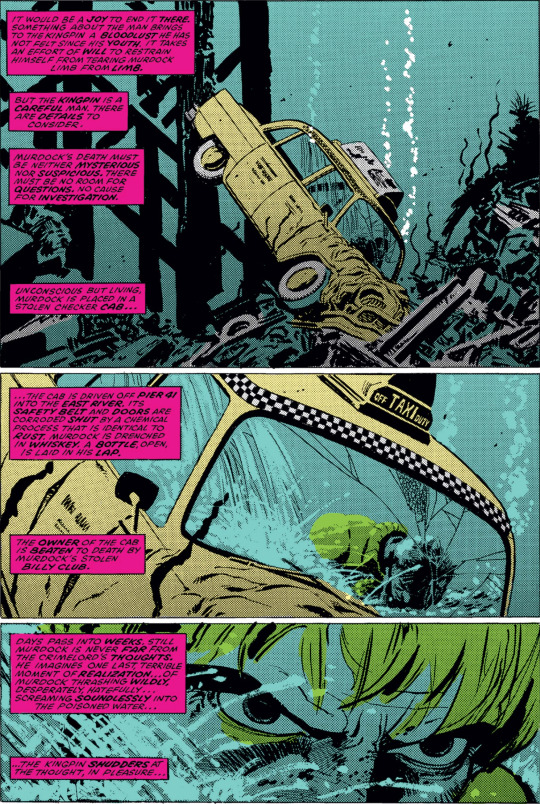

[ID: A taxi is resting at the bottom of a river with its hood bashed in. Matt Murdock is unconscious in the front seat. We see a close-up of his eyes as they open in a defiant glare. The next few panels show the Kingpin standing at a window looking out, and photos of the cab after it has been pulled out of the river.]
Caption: “Unconscious but living, Murdock is placed in a stolen checker cab… The cab is driven off Pier 41 into the East River. Its safety belt and doors are corroded shut by a chemical process that is identical to rust. Murdock is drenched in whiskey. A bottle, open, is laid in his lap. The owner of the cab is beaten to death by Murdock’s stolen billy club. Days pass into weeks. Still Murdock is never far from the crimelord’s thoughts. He imagines one last, terrible moment of realization… of Murdock thrashing wildly, desperately, hatefully… screaming soundlessly into the poisoned water… The Kingpin shudders at the thought, in pleasure… The world seems flooded with sunlight. Daily business becomes a joyous, childlike game. He has disgraced, destroyed and murdered the only good man he has ever known. This is his triumph of the spirit.
“At last the cab is discovered. There is blood, and bloody evidence of a struggle. There is a shattered windshield… a safety belt, severed by the windshield’s glass and what must have been a hideous effort of will. There is no corpse.”
Daredevil vol. 1 #228 by Frank Miller, David Mazzucchelli, and R. Lewis
This is, of course, from the famous “Born Again” arc, and I had a hard time choosing a scene, since the whole story is essentially a seven-issue-long depiction of Matt being knocked down and then standing back up. (I highly recommend reading it if anyone hasn’t, and I also summarized it here. I also cheated by including another scene at the beginning of this post…). However, the scene above is a turning point and possibly my favorite moment in the whole story. At this point Matt has lost it all: his friends, his career, his reputation, his money, and his home. In a fit of desperate, delirious anger, he attacks the Kingpin, who beats him unconscious and then– in the scene above– tries to kill him once and for all. The above issue starts with Matt curled up on a bed in a hotel room, unable to force himself to even move. He seems thoroughly beaten, and the Kingpin assumes the same, which is why he decides to stop toying with his victim and just finish the job. But in spite of all of this, Matt freaking Murdock refuses to die, and he somehow finds the strength to physically fight his way out of this seemingly unsurvivable situation. The fact that we don’t see him do it– that we only get the Kingpin’s reaction and that panel of Matt’s defiant glare after regaining consciousness– makes this act of resilience all the more powerful.

[ID: Daredevil is fighting the Vulture (the Spider-Man villain). Daredevil pins him to the ground and starts punching him in the face.]
Matt: “A while ago, you said I secretly wanted to die. You were wrong. Cowards want to die. I’m no coward. I’m proving it– to you and to myself– by beating you… you– and everything you represent… the death and decay that eat away at a man until he surrenders… the horror that pulls you down into the pit! Well, I’m not the surrendering kind, mister! Got that? I never give up!”
Daredevil vol. 1 #225 by Denny O’Neil, David Mazzucchelli, and Ken Feduniewicz
Matt is not at all a suicidal person (I’ve seen some fans claim otherwise, but he really isn’t), and this scene comes from a rare issue that covers that topic. It takes place shortly after Heather Glenn’s suicide, and it explores how the spectre of her death haunts Matt and Foggy’s lives afterward. In this story, the concept of death is represented by the Vulture, who Matt discovers trying to rob Heather’s grave. Later, he appears at the offices of Nelson and Murdock, which have just gone bankrupt. Upset by this loss, Foggy wanders up to the roof and contemplates his life, at which point he encounters the Vulture. Matt, fearing that Foggy might kill himself, goes up after him in costume and tries to fight the Vulture off. For a moment, during the fight, Matt contemplates whether he actually wants to lose, before returning to his senses and defeating both the Vulture and his own dark thoughts.
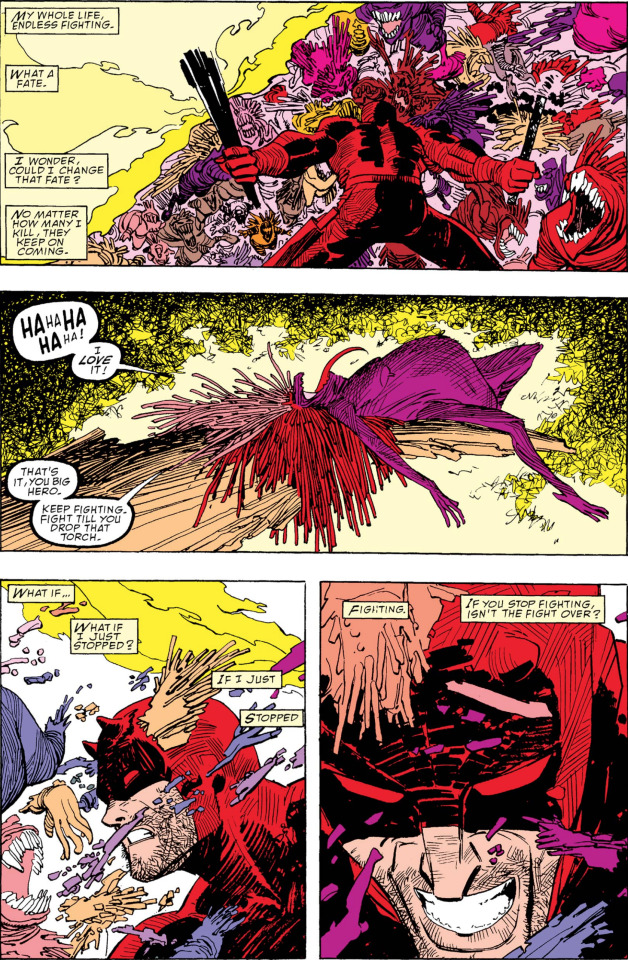
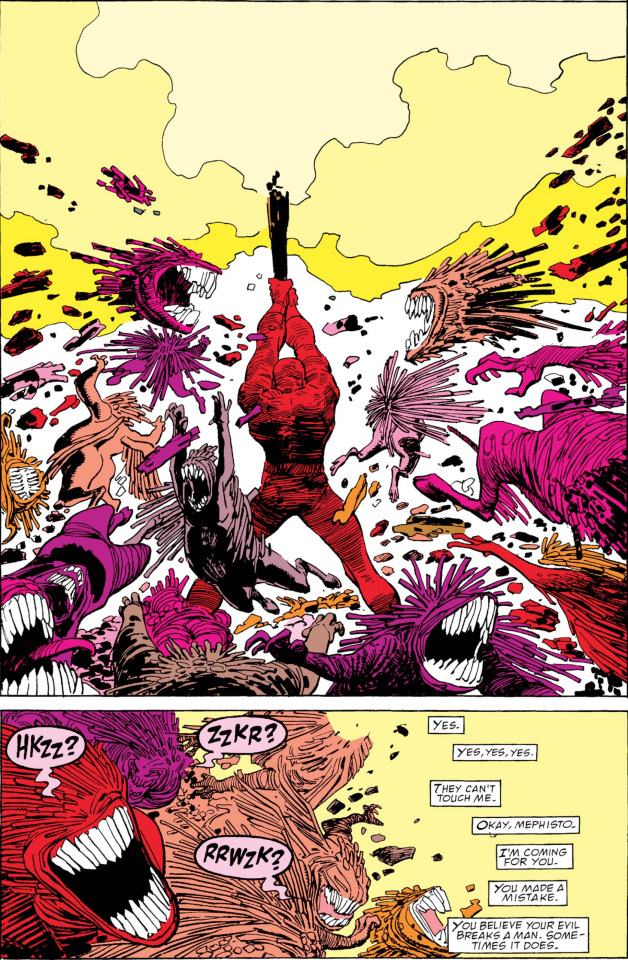
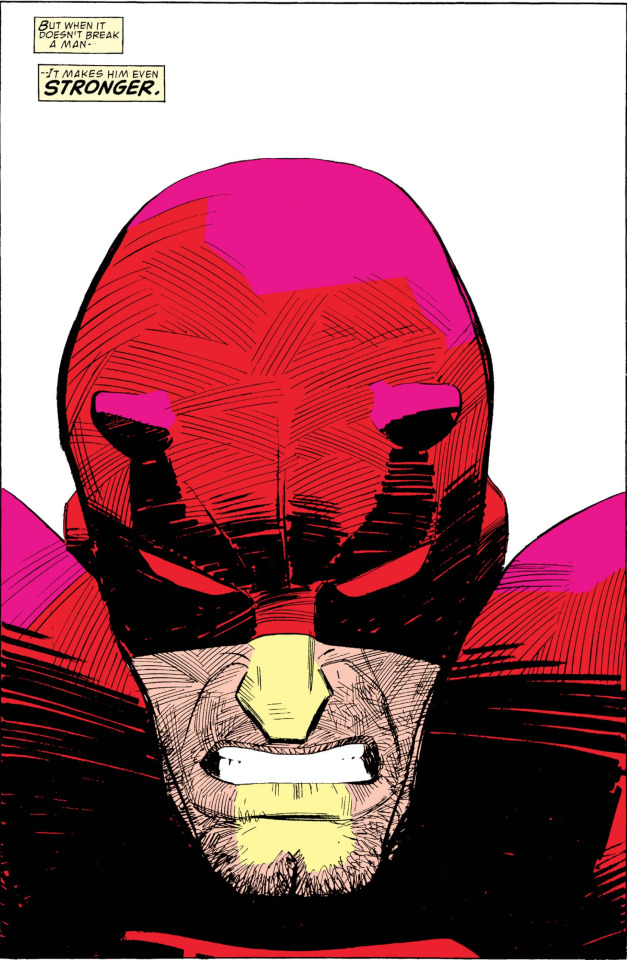
[ID: Daredevil is fighting a huge crowd of grotesque-looking demons while carrying a lit torch. He holds up the torch and the demons scatter.]
Matt: “My whole life, endless fighting. What a fate. I wonder, could I change that fate? No matter how many I kill, they keep on coming.”
Mephisto: “Ha ha ha ha ha! I love it! That’s it, you big hero. Keep fighting. Fight till you drop that torch.”
Matt: “What if… what if I just stopped? If I just stopped fighting. If you stop fighting, isn’t the fight over? Yes. Yes, yes, yes. They can’t touch me. Okay, Mephisto. I’m coming for you. You made a mistake. You believe your evil breaks a man. Sometimes it does. But when it doesn’t break a man– it makes him even stronger.”
Daredevil vol. 1 #281 by Ann Nocenti, John Romita Jr., and Christie Scheele
This is from Matt’s literal trip to Hell in Nocenti’s run (Hell is a cosmic setting in the Marvel universe, and Mephisto is a recurring antagonist, so this isn’t quite as bizarre as it sounds…). While trapped in a seemingly endless wasteland and attacked by hoards of demons, Matt musters enough free will and spirit (as represented by the fire he’s carrying) to not only survive, but to actually challenge Mephisto. It’s great.
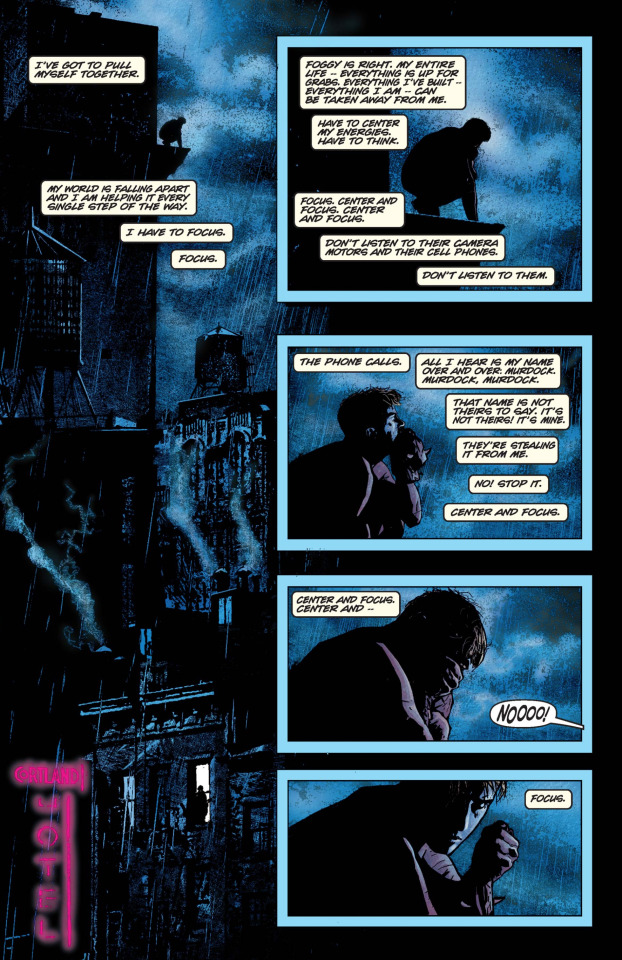
[ID: Matt is crouched on the side of a building at night, in the rain. He is wearing the Daredevil suit but has taken the mask off. He puts his hand to his face in emotional anguish.]
Matt: “I’ve got to pull myself together. My world is falling apart and I am helping it every single step of the way. I have to focus. Focus. Foggy is right. My entire life– everything is up for grabs. Everything I’ve built– everything I am– can be taken away from me. Have to center my energies. Have to think. Focus. Center and focus. Center and focus. Don’t listen to their camera motors and their cell phones. Don’t listen to them. The phone calls. All I hear is my name over and over: Murdock. Murdock, Murdock. That name is not theirs to say. It’s not theirs! It’s mine. They’re stealing it from me. No! Stop it. Center and focus. Center and focus. Center and–”
Mugging victim (off-panel): Noooo!”
Matt: “Focus.”
Daredevil vol. 2 #35 by Brian Michael Bendis, Alex Maleev, and Matt Hollingsworth
I love this little moment from Bendis’s run. It’s small and subdued, but highly moving in the context of what Matt is dealing with in this story. His identity has been made public, there are crowds of reporters camped outside his home, his entire life is at risk of falling apart, but he takes this second to pause, think, and regain some sense of control.

[ID: Matt stands up and prepares to fight. He is armed with two tonfa, and is wearing black clothes reminiscent of his Man Without Fear costume, but without a mask. His head is bandaged.]
Matt: “You think you can… turn me into a blubbering wreck… by preying on my fears… but I’ve already faced them– and come out the other side! You understand me, Calavera? I know what I am… who I am… and I am not afraid!”
Daredevil: Reborn #4 by Andy Diggle, Davide Gianfelice, and Matt Hollingsworth
The Reborn mini-series follows Matt’s attempt at emotional recovery in the aftermath of “Shadowland”. Having quite literally lost his identity and had his spirit broken by getting possessed by a demon, he goes out west and, through helping right some wrongs in a small town in New Mexico, he reaffirms his sense of self.
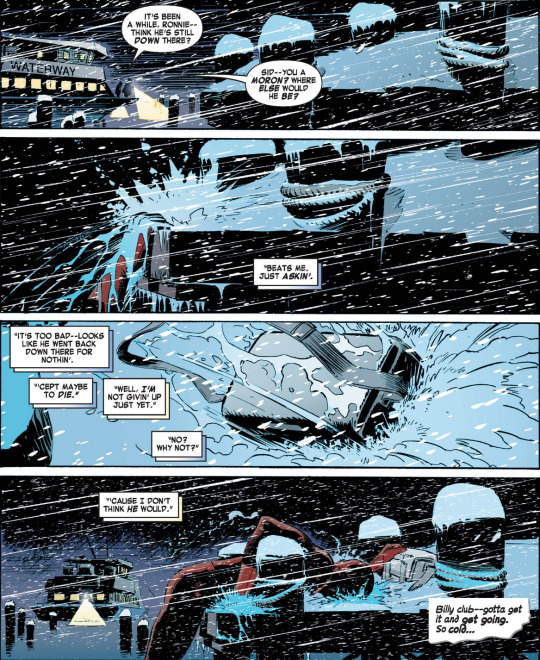
[ID: A stormy winter night. Ferry pilots (Sid and Ronnie, off-panel) are waiting for Daredevil to resurface from the river. As their ferry moves away, Daredevil hauls himself out of the freezing water and onto a dock.]
Sid: “It’s been a while, Ronnie– think he’s still down there?”
Ronnie: “Sid– you a moron? Where else would he be?”
Sid: “Beats me. Just askin’. It’s too bad– looks like he went back down there for nothin’. ‘Cept maybe to die.”
Ronnie: “Well, I’m not givin’ up just yet.”
Sid: “No? Why not?”
Ronnie: “’Cause I don’t think he would.”
Daredevil: Dark Nights #2 by Lee Weeks and Lee Loughridge
The first Dark Nights story is a celebration of Matt’s willpower, as he travels through a blizzard to deliver a heart transplant to a dying little girl. I particularly love this scene, in which Matt dives into the river to rescue the heart and the pilots transporting it from their crashed helicopter, and despite the cold and his exhaustion, he powers through and survives the experience.

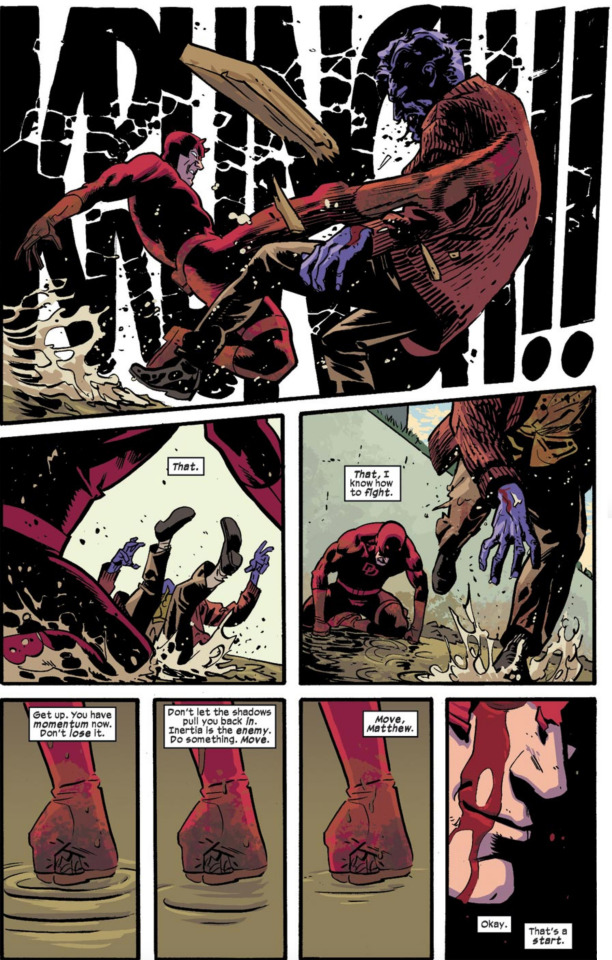
[ID: Daredevil is bleeding and horribly injured, and crouched in the mud under a bridge. The Purple Man is standing above him, about to hit him with a plank of wood.]
Purple Man: “Shouldn’t you be angry? Shouldn’t you put up a struggle?”
Matt (caption): “But that’s how far down the pit I’ve fallen. I can’t even respond to his orders.
Purple Man: “Come on. This is too easy. Don’t rob me of a victory I’ve waited years for.”
Matt (caption): “All I can do is sink into the blackness. I can’t feel pain. I can’t move because I have nothing to push against. Nothing.”
Purple Man: “Show me some fear.”
[ID: Daredevil kicks the Purple Man, then falls back to his knees. ]
Matt (caption): “That. That, I know how to fight. Get up. You have momentum now. Don’t lose it. Don’t let the shadows pull you back in. Inertia is the enemy. Do something. Move. Move, Matthew.”
Daredevil vol. 4 #10 by Mark Waid, Chris Samnee, and Matt Wilson
I’m glad you mentioned this scene because it’s one of my favorites too, as is this story arc as a whole. Waid’s depiction of depression is visceral and heartrending because it’s something he himself suffers from, and that realism makes Matt’s struggle to move forward and fight against his despair all the more impactful.
As an extension of the above moment, Matt’s decision to talk with Kirsten at the end of the issue (which I discussed at length here) is also breathtaking.

[ID: A black page with a red heart monitor readout at the bottom. It flatlines, then spikes once.]
Matt (caption): “I cannot see the light. So I will be the light. I am Daredevil. And I am not afraid.”
Daredevil vol. 5 #612 by Charles Soule and Phil Noto
And this moment– there’s nothing more badass than Matt literally willing himself back to life! “I am Daredevil. And I am not afraid” is a refrain that is repeated throughout Soule’s run, which is a neat way of tying his run together and emphasizing Matt’s relentless determination.
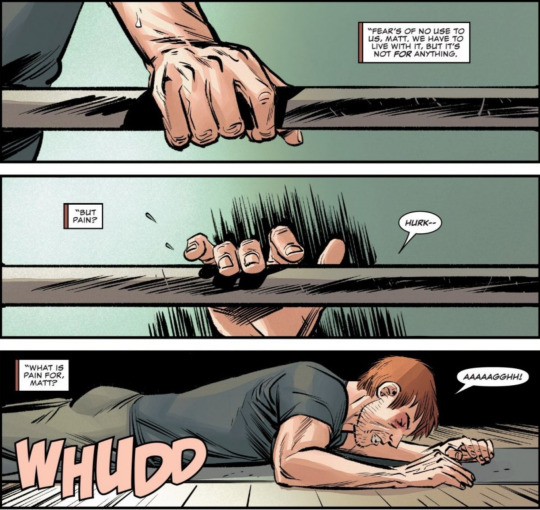
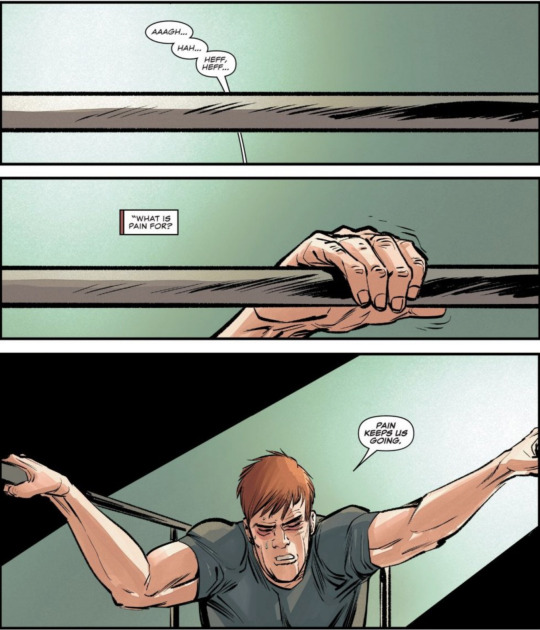
[ID: Matt is alone in a gym, struggling to walk between two parallel bars. He falls, then, with a huge effort, pulls himself back up.]
Jack (off-panel): “Fear’s of no use to us, Matt. We have to live with it, but it’s not for anything. But pain? What’s pain for, Matt? What’s pain for?”
Matt: “Pain keeps us going.”
Man Without Fear vol. 2 #5 by Jed MacKay, Danilo Beyruth, and Andres Mossa
The new Man Without Fear was another great recovery story, and gave us this really great moment when Matt, after suffering through the physical and emotional destruction of being hit by a truck, finally regains his fighting spirit.
I also wanted to include a few scenes of other people being inspired by Matt’s courage and resilience, because there are some great ones. Here’s one of my favorites, from Waid’s run:

[ID: Foggy is sitting in a circle with a group of fellow cancer patients. They are all wearing Daredevil shirts.]
Foggy: “Ah, excellent. You all dressed for the occasion. I’ll be straight up with you folks. I have a friend. He’s probably the bravest man I’ve ever met. And no matter how much I beg him to teach me to be like him… in the whole time I’ve known him, I’ve learned only one thing about fearlessness: it’s contagious.”
Daredevil vol. 3 #31 by Mark Waid, Chris Samnee, and Javier Rodriguez
I love this aspect of Foggy’s cancer plotline– the fact that Foggy uses Matt as a source of inspiration for facing his own fear. These two have always been emotional anchors for each other, providing moral support and guidance in difficult times, and that’s part of what makes their friendship so powerful. Here, Foggy is largely on his own. Matt can’t punch cancer, and Foggy doesn’t even tell him about the symptoms at first. But from the very beginning, Foggy latches onto Matt’s fearlessness as a way of fending off his own terror about the diagnosis. As I said at the beginning of the post, part of the purpose of superhero stories is to serve as inspiration for their readers to be kind and courageous in their own lives, and it’s wonderful when characters within those stories are impacted in that same way by the superheroes around them. To take this concept one meta step further, Foggy’s cancer story– the whole thing, including his drawing strength from his best friend– is in itself a hero story for readers who may be going through similar experiences.

[ID: Flashback panels colored in black and white with hints of red. Matt (in civvies) is attacked by a group of ninjas on a city street. He fights them while Foggy runs and hides around a corner.]
Foggy (caption): “When you were around, it was different. The fear wasn’t so real. I was still freaked whenever anything happened… my nerves were a car wreck… but even as I was sweating bullets, I somehow knew I was safe. Because of you.”
Daredevil vol. 2 #88 by Ed Brubaker, Michael Lark, David Aja, and Frank D’Armata
…And another great Foggy and Matt scene, this one from “The Secret Life of Foggy Nelson”, one of my favorite issues of Brubaker’s run. Foggy has been separated from Matt against his will, and in his isolation and fear, he reflects on their friendship and draws strength from Matt’s example.

[ID: Luke Cage is sitting comfortably in a chair, legs crossed, directly addressing the reader.]
Luke: “Daredevil. I know him pretty well, actually. Well, as well as he lets anyone know him. End of the day, without question, he’s one of the best. Ever. I’m not going to get into who he is and how he became who he became. And I know there are a lot of people who think they know all there is to know about Daredevil and all of his secrets. But I can tell you from personal experience that the information that’s out there about him is pretty much crap. Let’s just leave it at that. All you need to know about Daredevil is that this man has sacrificed everything to try to make this city safer. He has lost more and suffered more for his dedication to you than, well, anybody I know. And I know some people who’ve suffered and lost. He ain’t the strongest of us, and he ain’t the flashiest… but Daredevil cannot be brought down. It cannot happen.”
New Avengers vol. 2 #16 by Brian Michael Bendis, Mike Deodato, and Rain Beredo
And last but not least, here an excerpt from a great speech Luke Cage gives after Matt joins the Avengers. Even other superheroes– all of whom tend toward superhuman resilience– are impressed by Matt.
120 notes
·
View notes
Text













BLACKS BRITANNICA (1978) dir. DAVID KOFF
14 notes
·
View notes
Video
vimeo
In Search of the Miraculous from Polar Skate Co. on Vimeo.
In search of the Miraculous, a film by Pontus Alv. Made between 2005 and 2010. Filmed and edited by Pontus Alv. Concept and art direction by Klez Zawisa. Featuring, in order of appearance:
Part 1: Pontus Alv, Daniel Håkansson, Martin Nilsson, Danijel Stankovic, Pekka, Javier Mendizibal, Txus Dominguez
Part 3: Eniz Fazliov, Oskar Ristenfeldt, Jacob Ovgren, Phil Zwijsen, Ferit Batir, Mikael Persson, Colin Kennedy
Part 4: Alain Goikoetxea, Ben Smicker
Part 5: Johan Linö-Waad, Oskar Ristenfeldt, Mikael Persson, Johannes Marent, Hjalte Halberg
Part 6: Günez Özdogan
Part 7: Javier Mendizibal, Txus Dominguez, Eniz Fazliov, Julian Furones, Jan Kliewer, Ferit Batir, John Dahlquist, David Stenström, Jean-Louis Huhta, Christian Sjöberg
Part 8: Daniel Håkansson, Per Magnusson, Andreas Lindström
Part 9: Marcus Nyström, Daniel Håkansson, Patrik Evander, Marcus Olsson, Pontus Alv, Jean-Louis Huhta, Per Magnusson, Dirk Raßloff, Javier Mendizibal, John Magnusson, Al Partanen, Love Eneroth, Stefan Toth, Darren Navarette
Part 10: Michael Juras
Part 11: Mattias Nylén, Skreech, Dennis Busenitz, Chris Senn, John Magnusson, Sam Hitz, Al Partanen, Salba, Daniel Cardone, Jimmy the Greek, Ben Schroeder
Part 12: Scott Bourne, Julian Furones, Mattias Nylén, John Magnusson
Part 13: Fred Demard, Pontus Alv, Julian Furones, Guillaume Mocquin, Julian Viallet, Chris Merkt, Oli Buergin
Part 14: Love Eneroth, Johan Florell, Ricky Sandström, Mika Edin
Part 15: Daniel Håkansson, John Dahlquist, Mattias Nylén, Nils Svensson, Dennis Busenitz, Jimmy the Greek, Stefan Toth, Martin Nilsson, Marcus Olsson, Pontus Alv, Kos Mizkieviesz, Jean-Louis Huhta, Hans Claessens, Johan Linö-Waad, Kalle Helgesson, Martin Ottosson
Part 16: John Magnusson, Javier Mendizibal, John Dahlquist, Alexander Åkerlund, Andreas Lindström, Johan Linö-Waad, Stefan Toth, Kalle Pool B
Part 17: Danijel Stankovic, Koffe Hallgren, Hjalte Halberg, Pontus Alv
Part 18: Pontus Alv, Johan Linö-Waad, John Dahlquist, Love Eneroth, Stefan Toth, Eniz Fazliov, Tobias Henriksson, Johan Sunden, Danijel Stankovic, Per Magnusson, Mikael Persson, Marcus Olsson, Nils Svensson, Daniel Håkansson, Jonas Lindahl, Günes Özdogan, Hans Claessens, Martin Nilsson, Fernando Bramsmark, Oskar Ristenfeldt, Michal Juras, Kalle Pool B, Martin Ottosson
Part 19: Pontus Alv
Part 20: Johan Linö-Waad, Per-Kristian Hansson, Tobias Henriksson
34 notes
·
View notes
Photo

Komika Dodit Mulyanto berkesempatan mencium pipi Shandy Aulia dalam adegan di film 'Cinta Itu Buta'. Nah, sebelum itu Dodit izin dulu nggak ya sama sang kekasih? . Menurut Dodit, sang kekasih, Cici, tak cemburu saat mengetahui ada adegan ciuman dalam film tersebut. Sebab, Cici memahami pekerjaannya sebagai artis. . Ia pun tak meminta izin sang pacar. Apalagi, diketahui lawan mainnya merupakan aktris papan atas. . "Ya nggak lah (minta izin). Ngapain cemburu, sama Shandy masa cemburu. Sudah mau ada yang ajak main (film) jadi nggak perlu dijelasin lah," jelasnya di sela-sela konferensi pers 'Cinta Itu Buta' di Koffe Konco, Jakarta, Senin (7/10/2019). . Selain itu, ia juga mengaku tak sempat meminta izin ke suami Shandy Aulia untuk beradegan cium pipi. Sebab, Dodit tak tahu nomor kontak David Herbowo. . "Saya nggak sempat izin (sama David). Saya nggak punya WhatsApp suaminya," terangnya. . Sementara itu, Dodit mengaku beradegan mesra dengan Shandy Aulia merupakan keajaiban dunia. Sebab, ia tak pernah bermimpi bisa bersanding bersama. Sumber : hot.detik.com #shandyaulia #doditmulyanto #cintabuta #komika #artis #selebriti #tahu_nggak https://www.instagram.com/p/B3UTELkA98w/?igshid=ditm1xu87fn8
0 notes
Text
Dedicated to the memory of my dear friend Dr. Alok Ray (March 1937- June 2019)
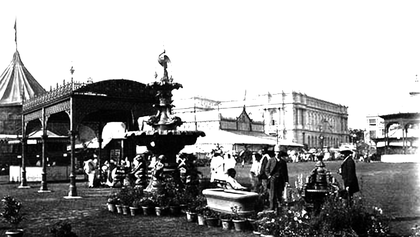
Calcutta International Exhibition 1883_84
ঔপনিবেশিক কলিকাতায় সাংস্কৃতিক বিনিময়
PROLOGUE If we believe that acculturation is an interactive process that brings about changes in lifestyles as well as moral and aesthetic values of two or more autonomous cultural systems, then it was a two-sided process of acculturation that happened in nineteenth-century Calcutta merging interests and identities of the two civilizations in encounter between a technologically superior Western society and a non-Western society inclined toward its empirical traditions. Acculturation in colonial India is generally interpreted as a deliberate process initiated by the British Orientalists and the English-educated enlightened Indians notwithstanding the dominating spirit of the 19th century nationalism in Victorian sense. In fact, on either side, players were products of the 18th-century world of rationalism, classicism, and cosmopolitanism. [Koff] Many Orientalists, notably William Jones, H. T. Colebrooke, William Carey, H. H. Wilson, and James Prinsep, made significant contributions to the fields of Indian philology, archeology, and history. On the other hand, Rammohun, Dwarkanath, Radhakanta, Debendranath, Vidyasagar and so many Indian reformists encouraged their fellowmen to get exposure to western science and literature, on top of vernacular sagacity. They effected in remarkably short time a widespread dissemination of western knowledge through institutionalized means like schools and colleges, printing-press and newspapers. By 1821, the Calcutta School-Book Society, sponsored by a number of public spirited individuals like David Hare, Rammohun, Radhakanta, belonging to different religious denominations, without any backing of Government grant, produced and distributed as many as 126446 copies useful works in different languages; no fewer than 14,792 were books in the English language’. Another interesting feature was the decrease in the demand for books in the Sanskrit, Arabic, and Persian languages, ‘being the spoken language of no one’. By 1835, the Society had sold 31,864 books in English. Five year before the Medical College in Calcutta started professional courses in English, it was claimed that Calcutta had in 1830 nearly 200 who wrote English as naturally as their mother tongue. As for Bengali language, long before the coming of the English in Bengal, the mother tongue of the majority had been discounted as simplistic and unworthy of official status. ‘The languages of the superior civil and commercial stations were English, Portuguese, and Persian, and ambitious Hindus made certain that of these they knew at least Persian’. It was Halhed who first urged upon British civil officers the necessity of acquiring knowledge of it for the efficient transaction of their duties. He argued for the Bengali language, before anyone else ever did, specifying its inherent qualities: ‘its plainness, its precision and regularity of construction, than the flowery sentences and modulated periods of Persian.’ His Grammar printed and published in Calcutta, gave practical support to his arguments, by providing British officers with a book from which they could learn the language. [Clark, 1956]
The earliest printed book in Bengali
No sooner Bengali becomes a popular medium of communication it started borrowing words from English and the English from Bengali as well. There have been many familiar words, e.g. coolie, cowrie, cot, curry, godown, pagoda, etc., originated from some other languages, commonly used by the English and the Bengalese. There are also some distinctively of Bengali origin, like babu and bungalow. A glimpse through Hobson-Joson may reveal many interesting evidences of liberal linguistic behavior of the Colonial Bengal despite the racial bias of which the world is continuing to suffer till today. As we understand from Sarah Ogilvie the author of ‘Words of the World’ that the former OED editor Robert Burchfield found to be an inward-looking anglocentrics who had erased 17 per cent of the ‘loanwords’ and ‘world English words’, Indic included, that had been added by earlier editor Charles Onions. [Ogilvie]
While all these conscious efforts of magnificent persona of both the camps created a short-lived glorious age of awakening and also a golden opportunity for a giant leap toward a modern society at par with global standards. Around 1880s that opportunity got lost. Western education reached a tiny proportion of the Indian population largely confined to the major urban centres. A chauvinistic nationalism back lashed the progressive movements. The undercurrent of acculturation, however, continued to flow effortlessly as conscious and unconscious acceptance of new ideas, often with the intention of revitalizing Indian cultural practices and institutions. Slowly steadily new things and ideas percolated through lairs to the bottom level of society undergoing series of changes through interactions. [Peers] What were those ‘new’ things and ideas? Historically speaking, the things and ideas branded ‘colonial’ are supposed to be grown out of Industrial Revolution directly or indirectly, which may be as big as Indian Rail or as small as a gramophone pin – everything targeted to make living in the colonial society convenient and agreeable.
Nipper, the dog is listening to a wind-up gramophone. New Vector Records September 1905 ad. Courtesy: HMV
It was still an industrial age when the Colonial style of living was being shaped through interactions with native environment. Changes incorporating new things and ideas were taking place faster and in an unprecedented large scale than ever happened in history because of the boon of technology. The Industrial Revolution, however, may not be seen as a movement for achieving speed and volume in industrial sphere. Its ultimate gain for the human society proved to be more an attitudinal change toward accepting values associated with new products than productivity itself. Acculturation during the colonial era may be more meaningfully interpreted, essentially in terms of the attitudinal changes.
EUROPEAN HABITATION IN CALCUTTA BEFORE 1830s Captain Williamson provided immaculate descriptions of the living conditions of late 18th century Calcutta that provides us with significant resource for identifying some down-to-earth relationship between the ‘new products’ of the Industrial Age and the formation of the ‘new society’, which yet to be fully surfaced.
The EIC officers adopting some local customs while remaining distinctly British_doyely
To the gentlemen coming to settle in Calcutta on civil, military, or naval service of the Hon. East India Company, Captain Williamson offered in his Vade Mecum many practical advices along with cautionary against belittling the native sagacity unwittingly while finding the most suitable mode of living for them. During Williamson’s time, between 1787 and 1798, a new Calcutta suburb was being born south of Town Calcutta to meet the craving of the settlers for ‘airy’ life close to Nature in the Gangetic Bengal mingled with the comfort and convenience of European way of living. New townships at Chowringhee-Dhurrumtollah locality were then only at their initial stage. In 1793-94, all over the town there were no fewer than 1114 pucca houses; in 1821 it increased to 14,230. [Oneil] The new suburbs grew faster with masonry houses built by Europeans and deshi well-to-dos as nucleus of new urban experience of ‘airy habitation’.
It is worth noting that the English inhabitants were still chiefly to be found ‘where their fathers had lived before them’ in the year 1810, Colonel Sleeman spoke of the residences of the Europeans as lying mainly between Dhurrumtollah and China Bazar; and the Tank Square was in the middle of the posh ‘Belgravia of his day’. [Cotton] This happens to coincide with the timeframe Williamson depicted in his Vade Mecum pinpointing some cultural issues involved in modeling ‘airy’ homes to live in comfy liberal style, which European settlers aspired to attain once they crossed Cossitollah toward further south. And so they did achieve their ‘model home’ through an intricate acculturation, after more than three decades of trials and errors, by coming into terms with indigenous methods and means of house building that the settlers initially tended to neglect. [Williamson 1810]
IN SEARCH OF A EUROPEAN MODE OF LIVING Williamson was one who believed that taking the general outline of indigenous customs should be considered an axiom for the settlers in exploring a new possibility of improving their quality of life. All the European settlers remained anxious to see airy habitations, through which the wind could pass freely in every direction. When the English first visited India, they adopted a mode of building by no means consistent with common sense, and displaying a total ignorance of the most simple of nature’s laws. For instance, they wasted much time to ‘become convinced that the most insupportable heats are derived from the glare of light objects’ and were to be judiciously used in designing habitats. Williamson’s advice to the settlers was ‘to coincide with the habits of the natives, to a certain extent if they mean to retain health or to acquire comfort’. Upon arrival, travelers learnt from local doctors that nine out of ten of the advices prescribed by doctors at London, would infallibly have sent them to ‘kingdom come!’ but readily approve the homie piece of good sense that ‘do as one should find the old inhabitants do’. Travelers, he observed, often suffer extreme inconvenience, and expose themselves to much danger because of the fact that they “bent on the refutation of the most reasonable assertions, and influenced by a ridiculous determination to support some equally ridiculous hypotheses”. Williamson tipped them with a piece of his mind: however absurd many indigenous practices may at first appear, it will ordinarily result that ‘necessity was their parent’.
British Styled Bungalow. Photographer: James Kerr (pumpparkphotos.com) c1880
All the buildings forty to sixty years old were, “like the celebrated Black-Hole, constructed more like ovens, than like the habitations of enlightened beings”. The doors were very small; the windows still less, in proportion, while the roofs were carried up many feet above both. Those roofs were in themselves calculated to retain heat to an extreme, being built of solid tarras, at least a foot thick, lying horizontally upon immense timbers, chiefly of teak, or of saul wood. Until around 1790s, the whole of the family resided in the first floor; leaving the whole of the ground floor as basements for reception of palanquins, gigs, cellars, pantries, and even stables. Since around 1780s their preferences changed in many ways. Living in single-floored thatched houses, styled as bungalows, became the way of European life. The settlers remained engaged indefatigably to improve upon the habitability of bungalow. They closed up all the intervals between the thatch, and the walls, on which it rested; so as to exclude the external air, as well as the dust: a practice religiously observed even to the present date. They improved upon the arrangement by installing a tin ventilator near the summits of the thatches. [Williamson 1810]
The shape and size of bungalows changed further having their apartments surrounded by a veranda, of full fourteen feet in width; with apertures, of a good size, in the exterior wall, corresponding with those of the interior. This arrangement renders the generality of bungalows remarkably pleasant; but, it must be noticed, that there was a very wide difference in the expense incurred in rendering them so, both as relating to the labor, and to the materials.
COLONIAL LIVINGSTYLE INVENTED As we discussed, Europeans modeled their new home and styled a new way of living for themselves through a continuous process of interactions between their own perceptions and desi sagacity. The model was generally found most comfortable and highly adaptable for living in changing Gangetic Bengal climate, and therefore the overall cost of a complete bungalow in tune of Rs 40,000, found quite acceptable by the well-to-do families of different cultural origin. Besides Europeans, there were quite a few desi families moved to Chowringhee-Dhurrumtollah to their newly owned bungalows. The natives of the land, on the other hand, increasingly appreciated whatever the settlers fashioned for their everyday use including bungalows, furniture fixture utensils wearable, as wonderful user-friendly amenities.
Major William Palmer with his second wife, the Mughal princess Bibi Faiz Bakhsh by Johann Zoffany, 1785.
Sketches Illustrating the Manners & Customs of the Indians & Anglo Indians | William Tayler/British Library
Nautch Girl or public female singer of India,” by Mrs. Belnos, London, c.1832. Source: ebay
A male Anglo-Indian being washed, dressed and attended by five Indian servants. Coloured lithograph by J. Bouvier, 1842, after W. Tayler. Iconographic Collections. Source: Welcome Images
The spread of English education might have a partial role in changing people mindset toward western culture – the way of life and the things they use every day. The ‘new products’ we talk about, however, more often than not, were made of old familiar things into new design; like a folding umbrella, for example. The settlers learnt by experience that it should be a madness to use a European umbrella, like a parapluie or a parasol, against a heavy Indian shower or a blazing sun. So they designed a new tough umbrella employing seasoned bamboos and heavy canvas to stand Indian weather best, and then add a collapsible holder inside to turn the old chattah into a surprisingly convenient ‘folding umbrella’. This novelty item was expected to be on high demand in Chandney shops, and the shops were expected to store umbrella and its parts as well to promote use of umbrella to all communities of Calcutta society.
A Fakir with umbrella. Details not known. Source: ebay
Bengalese Babu. Courtesy: Mary Evans.
Like the umbrella, there happen to be a innumerable new products originally designed and developed by the European settlers out of local ingredients generally employing local tools and technology to facilitate their living a decent comfortable life in India as they were used to. Such products of Colonial origin not anymore sensed as foreign to local habits and practice, and the locals feel at ease in using those, hand in hand with things they use traditionally in everyday life. Today, after a lapse of two centuries, Indian populace in general, have converted their mode of living so completely that rarely a dhoti-clad babu can be spotted on road unless he was to attend a special festive occasion. Desi dresses, Desi dishes ending with a bouquet of Benaresi pan will be soon things of forgotten past together with many essential items that remained parts of our heritage so long. The way the tune of Senhai is giving way to the resounding Rock music, every single item of our traditional pieces of life and art will be replaced with newer kinds in course of never-ending societal change.
Colonial-inspired house and interior design Courtesy: @myLusciousLife
HOUSE & FURNITURE Colonial Scenario: In all parts of the country houses are let with bare walls. Rent was expensive; some two hundred rupees a month for small house; which was then equal to three hundred pounds yearly. [Williamson 1813] Terrace-work is substituted for plank; and, being covered with a fine kind of matting, made of very hard reeds, about the thickness of a crow-quill, worked in stripes of perhaps a foot or more in breadth each gives a very remarkable neatness to the apartments; many of which, however, are laid with ‘satringes’ (সতরঞ্চি), or striped carpets, made of wool, or cotton, during the cold season. Carpets, in imitation of those manufactured at Wilton and Brussels, are now made in India; some of which are of incomparable excellence and beauty. The necessity which exists for keeping the doors and many windows open at all times renders it expedient to guard the candles, which are invariably of wax, from the gusts of wind that would speedily blow out every light. Shades, made of glass, are put over such candles as stand on tables.
Present-day Scenario Majority lives in rented accommodation; mostly unfurnished. Few have preference to ethnic furnishing with satringes’ (সতরঞ্চি), or striped carpets, sitalpapties, madoors, chics, ctc., while the generality love showy interiors with sofas, chairs centre table, side tables and so on. Urban folks keep doors closed, widows open all seasons except when gusty wind blows. Even then there is no need to guard candles as there no candle in use normally, but modern homes steel need shades for cutting the glare of electric lamps. As it appears, the mode and style of living in Calcutta now and then in many respects alike outwardly, yet an attitudinal difference remains much to explain why the homes of today so ill-kept in contrast with the spic and span Colonial home. The other notable difference is that the modern families ‘sacrifice comfort to appearance’ contradicting the principle of the Colonial Style as we have already discussed at length. . GARMENTS & OUTFITS Colonial Scenario:
Major-General Charles Stuart (circa 1758 – 1828), wrote his first article in 1798 about military clothing and there he professed the use of Indian clothing and accessories, as they are convenient and appropriate, attacking European prejudices. Better known as ‘Hindu Stuart’, Charles was not just an admirer of the Indian religions but also an enthusiastic devotee of Indian fashions. In a series of disputed articles in the Calcutta Telegraph he tried to persuade the European women of Calcutta to adopt the sari on the grounds that it was so much more attractive than contemporary European fashions. Because of his Hindu craze, Charles Stuart was certified as ‘gone native’. [Dalrymple]
The friends of the English young men, who are sent to the East Indies, generally fit them out with a great variety of apparel, and other articles, enumerated in the slop-merchant’s list under the head of “Necessaries” that basically include quantities of the followings: Calico Shirts, Stockings, Trousers, Drawers, Jackets, Waistcoats, Night Caps, Hats, Handkerchiefs, Neck Kerchiefs Or Bandana, etc. “Of these a large portion is entirely useless.” Among the indispensables, according to Williamson, should be a good stock of wearing apparel; generally speaking, white cotton, manufactured into various cloths; such as dimity, calico, if not made of nankeen. The beauty of some fabrics of this description was considered ‘very striking’. Thirty suits will not be found too many for a European in Calcutta society. [Williamson 1813]
A European, probably Sir David Ochterlony (1758-1825), in Indian dress, smoking a hookah and watching a nautch in his house at Delhi. Artist: unknown. c.1820. Courtesy: BL
Present-day Scenario Inside home, Calcutta men commonly wear pajama kurta (পাঞ্জাবী), and the ladies stuck to sari (শাড়ি) wherever they go, inside or outside, till around 1980s when a wave of Anglo-American fashion maxi midi mini dresses became choices of convenience for the young ladies that ultimately gave way to oriental varities of salwar kamiz. Outside, almost all men folks and children of both sexes appear in western attire – but with no caps on head. The corporate or institutional dress codes in Calcutta do not insist to wear a headdress – a useful accessory for resisting weather bite, but a necktie around the neck to look smarter at the cost of agonizing physical discomfort. There were quite a few things Europeans invented for tropical climate that become obsolete now in spite of their latent advantages. The Sola-topee or topi, may serve a good example of such things. Topi is made of lightweight sholapith covered with khaki or white cloth. The reason for using sola is its lightness and its heat-resistant capacity for protecting head from the scorching tropical sun, cleverly fitted with two tiny holes at both sides for ventilation. Colonial men and women loved to wear it for convenience and comfort, Indians rejected it possibly because of its prosaic appearance on the first place.
KITCHEN & TABLEWARE Colonial Scenario: The favourable oriental dejeuner usually consisted of tea, coffee, eggs, toast, and fish, (either fresh or slightly powdered with salt, rice, &c.). Many gentlemen, especially those from North Britain, add sweetmeats and soogee; the latter corresponding with porridge, oats, which were not cultivated in India. Of all things of European liking Hilsa might be the foremost. The fish tasted ‘remarkably fine’ especially when baked in vinegar, or preserved in tamarinds worcestersauce.
The knives and forks were all of European manufacture, though, within few years, some excellent imitations appeared in market. The greater part of the plate, used throughout the country, was made by native smiths, who, in some instances, might be seen to tread very close on the heels of English jewelers. Table cloths and napkins were manufactured in several parts of the country, where ‘piece goods’ were made, especially at Patna.
Present-day Scenario
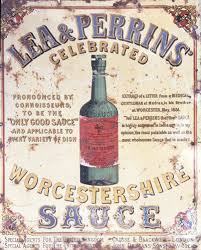
Not for breakfast alone, tables for lunch and dinner (or supper as it was called then) resemble by and large what commonly Calcuttans having these days. Although, Bengalese still prefer to use hands in dining at home, cutlery are being used increasingly along with a large number of local variety of tableware like Tea Cups and Plates, Tea Cozy, Pepper Grinder, Salt Shakers, Napkins, and Pickles, Vinegar & Sauce as for instance. The English, as we all know, is basically a highly traditional race who still calls their lamb cutlet a ‘mutton cutlet’ retaining the French legacy of the product they had borrowed. Following the same tradition they call many products of Indian origin with vernacular appellations. On the contrary, in case of the colonial products, which they designed and developed using local ingredients and technology, reference to the source of origin is rarely provided. The story of the world famous Worcestershire Sauce and the theme British Curry may exemplify my view point adequately.
LEA & PERRINS® .The story of Lea & Perrins® famous Worcestershire Sauce begins in the early 1800s, in the county of Worcester. Returning home from his travels in Bengal, Lord Sandys, a nobleman of the area, was eager to duplicate a recipe he’d acquired. On Lord Sandys’ request, two chemists, John Lea and William Perrins, made up the first batch of the sauce but were not impressed with their initial results. They needed few years more to find right kind of aging process to turn the ingredients into a delicious savoury sauce. Without any kind of advertising, in just a few short years, it was known and coveted in kitchens throughout Europe.
Portrait of William Fullerton of Rosemont, Dip Chand, Murshidabad, India, 1760-1763. Opaque watercolour on paper. Company Painting. Courtesy: VAM
In the space of a few years Duncan, a New York entrepreneur, was importing large shipments to keep up with demand. Lea & Perrins was the only commercially bottled condiment in the U.S., and Americans loved it right away. Almost 170 years later, Lea & Perrins sauce remains a favorite in households across the U S.
BRITISH CURRY. “The idea of a curry is, in fact, a concept that the Europeans imposed on India’s food culture. Indians referred to their different dishes by specific names … But the British lumped all these together under the heading of curry.” [Collingham] In fact, there are many varieties of dishes called ‘curries’. In original traditional cuisines, the precise selection of spices for each dish is a matter of national or regional cultural tradition, religious practice, and, to some extent, family preference. Such dishes are called by specific names that refer to their ingredients, spicing, and cooking methods. Curry, which becomes now Britain’s adapted national dish, is largely viewed as an Anglo-Indian theme. Luke Honey, a columnist, writes “how fond I was of Anglo-Indian curry powders; the sort of thing I chuck into stews and then have the nerve to call ‘curry’”. He made his own version of Dr Kitchener’s curry powder, as described by Mrs Beeton. He slightly adapted it for the modern kitchen and added cardamom and black pepper. [Honey] Wyvern’s recipe for basic powders reveals a large number of similar ingredients, hinting at very similar flavour profiles. They all include turmeric, cumin seed, fenugreek, mustard seed, black peppercorns, coriander seed, poppy seed and dried ginger and chilies.
In 1810, the entrepreneur Sake Dean Mahomed, from the Bengal Presidency, opened the first Indian curry house in England: the Hindoostanee Coffee House in London. The theme of British Curry, as distinguished from Proto-Curry and Anglo-Indian Curry, presumes that Curry is the result of over four hundred years of British interaction with India. As the findings of a recent British academic research suggests, Curry is a way that the British made Indian cuisine understandable in their minds and on their palates. It is more than a mixture of Indian spices, an idea or a symbol of the success of British imperial endeavors in possessing, converting and incorporating an object of other i.e. of India, into their world. [Waldrop]
BRITISH GIFT OF TEA CULTURE TO INDIAN PEOPLE
British Tea Tea Culture of India, Calcutta in particular, tells a fascinating story of social dynamics involving the ways of life of the British and the Indian people. The British gifted Tea Culture to India where they cultivated tea plants of native origin as well as the Camellia sinensis variety that Robert Fortune smuggled from China in 1849 for the East India Company. In Britain initially it was a luxury of the high society under the spell of Braganza the Queen Consort of Charles II during 1662 -1685, who happened to be the primary motivator behind the emerging British tea culture. Because the British East India Company had a monopoly over the tea industry in England, tea became more and more popular; and as its prices slowly fell, the luxury of drinking tea became middle-class habit. At the close of the 18th century tea – a cheaper drink than bear – turned out to be the drink of Britons of every class. There have been, nonetheless, the ways of making tea and taking tea remain distinctive of every class conforming nuances of tea culture. The popularity of tea, its respectability and domestic rituals, supported the rise of the British Empire, and “contributed to the rise of the Industrial Revolution by supplying both the capital for factories and calories for labourers” . Tea became the national drink of Britain. [Mintz]
Colonial India In late 1870s the drinking of tea was in fashion all over India and commonly a part of everyday informal social meets. [Mandelslo] We can see from contemporary writers that ladies and gentlemen had occasions to socialize themselves many a time a day – at breakfast, lunch, afternoon tea, supper, dinner, and after-dinner – and never without cups and shimmering teapots to induce sharing of minds. Calcutta was then a city of ceremonials and carnivals.
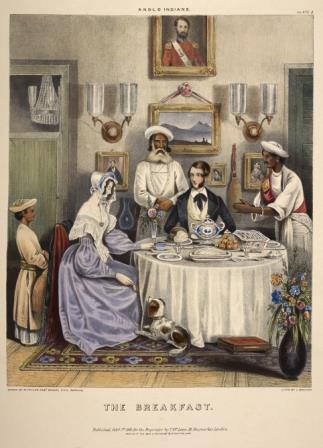
Tea-parties were enlivened with spirit of sociability where anything could be discussed, less the delicate subjects like tea growing and its politics and economics. Tea and the Britain have a shady history. ‘The British brought tea to England by way of monopolistic trade, smuggling, drug dealing, and thievery’ as modern research admits [Petras]. The Colonial India produced highest bid tea in auction markets by employing bonded labourers from Assam and North Bengal. From Calcutta, troops of hair-dressers and shoe-makers of Chinese origin were also called to join on the presumption that every Chinese a good tea-plucker. The plight of these hapless slaves was first known when Ramkumar Vidyaratna and Dwarkanath Ganguly reported in Sanjibani (সঞ্জিবনী) aroud 1886 [Ganguly] long before Mulk Raj Anand portrayed their misery in his famous Two leaves and a bird appeared in 1937. [Anad]
Recent Scenario The Tea Culture in India virtually started with the Tea Cess Bill of 1903 provided for levying a cess on tea exports – the proceeds of which were to be used for the promotion of Indian tea both within and outside India. Large hoardings and posters for tea recipes were put up in Indian languages, on several railway platforms; at Calcutta tram terminals they distributed free cups of tea, added with milk and sugar to make the drink agreeable to uninitiated tongues, and the like promotional plans put into operation to convert the teetotaler Indian public, especially the Bengalese, into a tea-addict race to whom ‘every time a tea time’. The plans, however, failed to meet their goal so long the aggressive opposition from the Swadeshi camp was in force. Gandhi called tea ‘an intoxicant’, in the same class of avoidable substances as tobacco and cacao. In the early 1920s, Acharya Prafulla Ray, an eminent chemist and a passionate nationalist, published cartoons equating tea with poison [Sanyal], in contrast of the British outlook that drinking tea is good for health of every family member including the dog. “Young dogs are frequently kept in health by a cup of tea being given to them every day.”[Roberts]
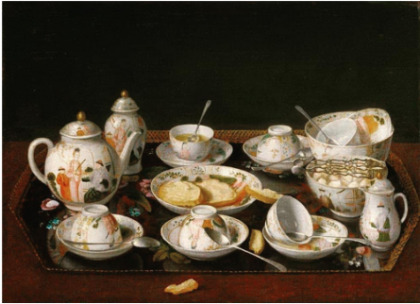
Tea Set. Oil on canvas. Artist: Jean-Étienne Liotard. 1781-83. Courtesy:Getty Center
Rabindranath Tagore, to whom the spirit of nationalist was never chauvinistic, welcomed tea cordially not only as a refreshing drink but an engaging Culture as he had experienced in Japan in 1916. He also established at Santiniketan a unique café exclusively for tea, ‘Cha-Chawkro’ (চা চক্র) in around 1929 – an addaa for the চা-স্পৃহ চঞ্চল চাতক দল tea lovers, [Chakraborty 2019]. Cha-Chawkro probably was the third stand-alone Tea Room in India, the first being The Favourite a typical vernacular tea joint set up in1818, and the second, a typical well-groomed Anglican tea-shop that the Swish Mr. and Mrs. Joseph Flury opened in 1927 under the banner “Flurys”.
Today’s Flurys is no more a tea-room – but surely a brazen joint best known for its exquisite breakfast meals. The décor has given away its colonial vibe for a fusion of cultural trends of no character of its own. [Majumdar,2009]
The old Favourite Cabin, however, still continuing with its inimitable tea-culture indigenously developed since 1918. Excepting the tea tables, crockery and the style of tea making, Nutan Barua, and his elder brother Gaur, borrowed nothing from the English to steer this first stand-alone tea room making a history contributed by generations of regular customers, many of them were firebrand writers, political activists, and young intellectuals. The tea-table manners were guided by the unwritten codes the customers formed themselves over the years that surely helped the cafe in continuing with its esprit de corps so long. [Bhaduri]
Other than the three pioneering tea shops we discussed Calcutta had quite a few local bistros famous for their addictive teas, often with some fried specialties. Basanta Cabin, Jnanbau’s tea stall, in North, Radhubabu’s stall, Sangu Valley, Bonoful in South, and Café de Monico at the city centre had been then crowdie hangouts of different social groups who were largely responsible for hauling an independent tea culture of this colonial city. Although the tea industry is still looking optimistically for the prospect of India’s National Drink status, the culture of Tea is seemingly dying a silent death. Already assaulted by coffee and the American soft-drink lobbyists, it may not stand the shock of being robbed its very identity in recent time. The good name of ‘tea’ is now being abused to mean some novelty refreshments that have little or no tea content, but mostly made of heady spices often with large proportion of milk and sugar. Such brands of desi teas sound like new versions of Gandhian tea now being marketed as Tulsi tea, Masala tea, Malai tea, Rhododendron tea, and the like. The Kahwa tea, is however different being the soul-warming drink of the Kashmiris and a part of their culture. All these refreshment drinks, of dissimilar taste and flavour, meant for people of different mind-sets than those who enjoyed tea the way Tagore’s Gora did, or a Nazrul did in Favourite Café, or someone, not necessarily an intellectual like Sydney Smith [Smith], who thanks God for tea, wondering “What would the world do without tea! How did it exist? I am glad I was not born before tea.”
END NOTE It is highly interesting to note, all these ‘new things’ created by the Europeans for themselves proved in no time to be equally good for Indian homes. Those products actually gave indigenous people an exposure to alternative styles of living and an opportunity to preview their relative merits that instigated necessary attitudinal change to tolerate differences in socio-cultural values and accept what found ‘best’ for them objectively. This attitudinal change we may consider as an indispensable condition for bringing about the ‘Awakening of Bengal’ and its recurrences around 1880s and 1930s.
REFERENCE
Anand, Mulk Raj. 1937. Two Leaves and a Bud. Bombay: Kutub.
Bhaduri, Arka. 2019. “ফেবারিট কেবিন.” Indian Express, May 9, 2019. https://bengali.indianexpress.com/west-bengal/favourite-cabin-a-century-old-kolkata-cafe-college-street-100180/.
Biswas, Oneil. 1992. Calcutta and Calcuttans From Dihi to Megalopolis. Calcutta: Firma KL. https://archive.org/details/in.ernet.dli.2015.149376.
Chakraborty, Sumita. 2016. “শান্তিনিকেতনে চিন ও জাপান.” Parabas, 2016. https://www.parabaas.com/rabindranath/articles/pSumita_china-japan.html.
Chunder, Rajarshi. 2016. “Dishes and Discourses: Culinary Culture at Jorasanko.” Sahapedia. 2016. https://www.sahapedia.org/dishes-and-discourses-culinary-culture-jorasanko.
Collingham, Lizzie. 2006. Curry: A Tale of Cooks and Conquerors. London: Vintage Books. https://books.google.co.in/books/about/Curry.html? id=Sr3GUyWe3O0C.
Cotton, H E A. 1907. Calcutta: Old and New; a Historical and Descriptive Handbook of the City. Calcutta: Newman.https://archive.org/details/calcuttaoldandn00cottgoog/page/n3
Dalrymple, William (2002). White Mughals: Love and Betrayal in 18th-century India. London: Harper.
Davies, Pauline. 2013. “East India Company and the Indian Ocean Material World at Osterley, 1700-800,.” Internet: East India Company at Home. 2013. https://blogs.ucl.ac.uk/eicah/osterley-park-middlesex/osterley-case-study-winds-of-trade/.
Gandhi, Arun. 2014. Grandfather Gandhi. NY: Atheneum Books. https://books.google.co.in/books?id=wduwz6-DapAC&printsec=frontcover&source=gbs_ge_summary_r&cad=0#v=onepage&q&f=false.
Honey, Luke. 2008. “Dr Kitchener’s Curry Powder.” The Greasy Spoon. 2008. https://lukehoney.typepad.com/the_greasy_spoon/2008/11/dr- kitcheners-curry-powder.html.
Koff, David. 1969. No TitleBritish Orientalism And The Bengal Renaissance 1773-1835. Calcutta: Firma KL. https://archive.org/details/in.ernet.dli.2015.98306/page/n7.
Mahomet, Sake Deen. 1794. The Travels of Dean Mahomet : A Native of Patna in Bengal, through Several Parts of India, While in the Service of the Honourable the East India Company. [Ireland]: Cork. https://archive.org/details/b28742898/page/n5.
Majumdar, Rakhi. 2009. “Into the Future: Apeejay Surrendra Group Post Jit Paul.” ET :Jun 04, 2009, 2009. https://economictimes.indiatimes.com/into-the-future-apeejay-surrendra-group-post-jit-paul/articleshow/4617853.cms?utm_source=contentofinterest&utm_medium=text&utm_campaign=cppst.
Mandelslo, Johann Albrecht von. 1669. Voyages Celebres & Remarquables, Faits de Perse Aux Indes Orientales. London: John Starkey, and Thomas Basset. https://archive.org/details/voyagescelebresr00mand/page/n8.
Mintz, Sidney W. 1993. “The Changing Roles of Food in the Study of Consumption.” In Consumption and the World of Goods; Ed. by Brewer, John; Porter, Roy. NY: Routledge. https://www.amazon.com/Consumption-World-Goods-Culture-Centuries/dp/0415114780.
Ogilvie, S. (2012). Frontmatter. In Words of the World: A Global History of the Oxford English Dictionary (pp. I-Vi). Cambridge: Cambridge University Press. https://doi.org/10.1017/CBO9781139129046″>https://doi.org/10.1017/CBO9781139129046
Peers, Douglas M. 2006. No TitlIndia under Colonial Rule: 1700-1885. NY: Routledge. https://books.google.co.in/books? id=dyQuAgAAQBAJ&printsec=frontcover&source=gbs_book_other_v ersions_r&redir_esc=y#v=onepage&q&f=false%0A%0A.
Petras, Claire. 2013. “British Tea 17th-19th Century.” Clairepetras.Com. 2013. http://clairepetras.com/history/ . Roberts, Emma. 1837. Scenes and Characteristics Hindostan,with Sketches Of Anglo-Indian Society. Vol. 1 (2). London: Allen. https://archive.org/details/scenesandcharac04robegoog.
Sanyal, Amitava. 2012. “Mahatma Gandhi and His Anti-Tea Campaign.” BBC News Magazine, May 2012. https://www.bbc.com/news/magazine-17905975. Shastri, Shibanath. 1909. রামতনু লাহিড়ি ও তৎকালীন বঙ্গসমাজ. The British Journal of Psychiatry. 2nd ed. Calcutta: SK Lahiri. https://doi.org/10.1192/bjp.111.479.1009-a.
Smith, Sidney. 1855. A Memoir of the Reverend Sydney Smith. By His Daughter, Lady Holland. With a Selection from His Letters. NY: Harper. https://archive.org/details/memoirofreverend02smituoft/page/n6.
Waldrop, Darlene Michelle. 2007. “A Curried Gaze: The British Ownership Of Curry.” Univ. Georgia.
Williamson, Thomas. 1810. East India Vade Mecum; or, Complete Guide to Gentlemen Intended for the Civil, Military,or Naval Service of the Hon. East India Company; Vol. 2 (2). London: Black, Parry. https://www.scribd.com/document/305022589/The-East-India-Vade-Mecum-Volume-2-of-2-by-Thomas-Williamson.
Williamson, Thomas. 1813. Costume and Customs of Modern India from Collection of Drawings by Charles Doyley… Ed. by Thomas Williamson. Oxford University. Vol. XXX. London: Edward Omre. https://books.google.com.au/books?id=VNFbAAAAQAAJ&pg=PP7&hl=en#v=onepage&q&f=false.
WAYS OF LIFE IN COLONIAL CALCUTTA: CHRONICLE OF ACCULTURATION
Dedicated to the memory of my dear friend Dr. Alok Ray (March 1937- June 2019) ঔপনিবেশিক কলিকাতায় সাংস্কৃতিক বিনিময়
WAYS OF LIFE IN COLONIAL CALCUTTA: CHRONICLE OF ACCULTURATION Dedicated to the memory of my dear friend Dr. Alok Ray (March 1937- June 2019) ঔপনিবেশিক কলিকাতায় সাংস্কৃতিক বিনিময়
#acculturation#acharya prafulla ray#addaa#and fish#and pickles#anglican tea-shop#Anglo Indian#awakening of bengal#babu#bandana#basanta cabin#black hole#bonoful#braganza#british curry#british gift#bungalows#café de monico#Calcutta School-Book Society#calico shirts#camellia sinensis#captain williamson#cha-chawkro#charles stuart#chauvinistic nationalism#chics#china bazar#classicism#coffee#colonel sleeman
0 notes
Text
OPERA / 2018-2019
EUGENE ONEGIN
TEACHER AND PARENT GUIDE
Washington National Opera Open Rehearsal Music by Pyotr Ilyich Tchaikovsky Libretto by Pyotr Ilyich Tchaikovsky and Konstantin Shilovsky Based on the novel by Alexander Pushkin
Student Guide: Eugene Onegin

Parents, Teachers, and Caregivers: We’ve Got You Covered
Hey there, adults. We’re sure you’re already familiar with the concept of opera but, just in case you’re looking for a refresher or you want to go deeper, here are some thoughts that may be of interest:
Opera A 400-year-old genre born in Italy that was cultivated throughout Europe from the sixteenth to the nineteenth centuries and eventually made its way to the United States (that’s right, Americans write operas, too). As you’ve probably guessed, there will be singing. Lots of it. Just think of it as heightened speech. A soprano may hit a really high note when she’s angry or scared. A bass might lay down a low note when he wants to be extra menacing.
Outside of the opera house, Eugene Onegin lives a whole other life as one of the most celebrated pieces of Russian literature of all time. Written over a span of eight years by the eminent national author Alexander Pushkin, the unusual novel-in-rhyming-verse is equal parts satirical social commentary and pure, unadulterated nostalgia. Its central tragic love story (boy meets girl, boy snubs girl only to discover, too late, he actually loves her) is about as good as dramatic irony gets, and its heroine, Tatiana, is viewed by many as the ultimate moral ideal—a perfect example of grace and dignity under pressure.
It’s no wonder then, that Pyotr Ilyich Tchaikovsky (cheye-KOFF-skee)—then a reasonably successful composer but only a moderately successful operatic composer—was almost instantly enchanted by Eugene Onegin. Indeed, he was so enthusiastic about the story that, legend has it, he began an outline for the opera almost the very minute he finished reading the book. He wrote to his brother Modeste on the subject, saying:
“I am under the spell of [Pushkin’s] verse, and I am drawn to compose the music as it were by some irresistible attraction. I am lost in the composition of the opera.”
Tchaikovsky’s music and Pushkin’s story turned out to be a match made in opera heaven (and it wouldn’t be the only time Tchaikovsky used Pushkin as inspiration—see The Queen of Spades, for example). Dubbed a set of “lyric scenes in three acts,” Tchaikovsky’s Eugene Onegin gives audiences a glimpse into the most riveting moments of Pushkin’s sprawling drama, while occasionally softening the characters to make them more sympathetic. The composer’s facility with folk tunes helped him paint a vivid picture of country life, and his gift for soaring melody lent itself perfectly to Onegin’s more intimate scenes such as Tatiana’s now famous letter aria and Lensky’s heartbreaking lament. Add these elements together and you’re left with a romantic opera with a nationalistic flare that has international appeal. Eugene Onegin remains a beloved fixture in opera houses across the globe.
Some recordings and resources you may want to check out:
Eugene Onegin with Dmitri Hvorostovsky, Nuccia Focile, and Neil Shicoff, conducted by Semyon Bychkov
Eugene Onegin with Thomas Hampson, Karita Mattila, and Piotr Beczala, conducted by Jiří Bělohlávek
Eugene Onegin with Bernd Weikl, Teresa Kubiak, and Stuart Burrows, conducted by Sir Georg Solti
The original novel. Widely considered one of the greatest pieces of literature Russia has ever produced, Alexander Pushkin’s Eugene Onegin draws on the likes of Byron and Shakespeare, resulting in a rhyming epic poem that explores art, love, social class, and authentic feeling in the early nineteenth-century Russian hinterlands.
Tchaikovsky’s Eugene Onegin, 2007. Captured at New York’s Metropolitan Opera, this video features Valery Gergiev (conductor) and Dmitri Hvorostovsky (Onegin) in a critically-acclaimed production that also stars soprano Renée Fleming and tenor Ramón Vargas.
You’re ready for Tchaikovsky’s Eugene Onegin.
-
All photos by Todd Rosenberg for the Lyric Opera of Chicago
Writer: Eleni Hagen
Content Editor: Lisa Resnick
Logistics Coordination: Katherine Huseman
Producer and Program Manager: Tiffany A. Bryant
-

David M. Rubenstein Chairman
Deborah F. Rutter President
Mario R. Rossero Senior Vice President Education
Timothy O’Leary General Director
Francesca Zambello Artistic Director
Major support for WNO is provided by Jacqueline Badger Mars.
David M. Rubenstein is the Presenting Underwriter of WNO.
WNO acknowledges the longstanding generosity of Life Chairman Mrs. Eugene B. Casey.
WNO's Presenting Sponsor

This performance is made possible by the Kimsey Endowment; The Morris and Gwendolyn Cafritz Foundation and the U.S. Department of Education.
Major support for educational programs at the Kennedy Center is provided by David M. Rubenstein through the Rubenstein Arts Access Program.
© 2019 The John F. Kennedy Center for the Performing Arts
0 notes
Photo


Congratulations to the thirteen artists selected to participate in our June event at 3S Artspace in Portsmouth, New Hampshire! Shannon Grecula, OH Christopher O'Flaherty, CT - http://christopheroflaherty.com/ Jake Cassevoy, MA - http://www.jakecassevoy.com/ Sarah Koff Studio, NH - http://www.sarahkoffstudio.com/ Kerry O. Furlani, VT - http://www.kerryofurlani.com/ Julie Crane, ME - http://juliecrane.com/ Jeffrey Fay, CT - http://jhutchinsonfay.com/ Kristy Cavaretta, ME Jenya Damsky, MA Madeline Gaffey, NH - http://www.madelinebgaffey.com/ David Witbeck, Artist, RI - http://www.witbeck.com/ Linda Behar, RI - http://www.lindabehar.net/ Ali Keller, NH - http://www.alikeller.com/ We'll be helping these folks print on Saturday and Sunday June 3rd and 4th at 3S's amazing gallery space. Come by and witness our mobile 4' x 8' etching press, "The Big Tuna" in action! The deadline for our next event at Maryland Hall for the Creative Arts is May 25th! Join us as we print in Annapolis, MD. Apply today for free at www.bigink.org/apply.
#woodblock#woodcut#print#printmaking#callforentries#callforart#bigtuna#bigink#reliefprint#reliefcarving
7 notes
·
View notes